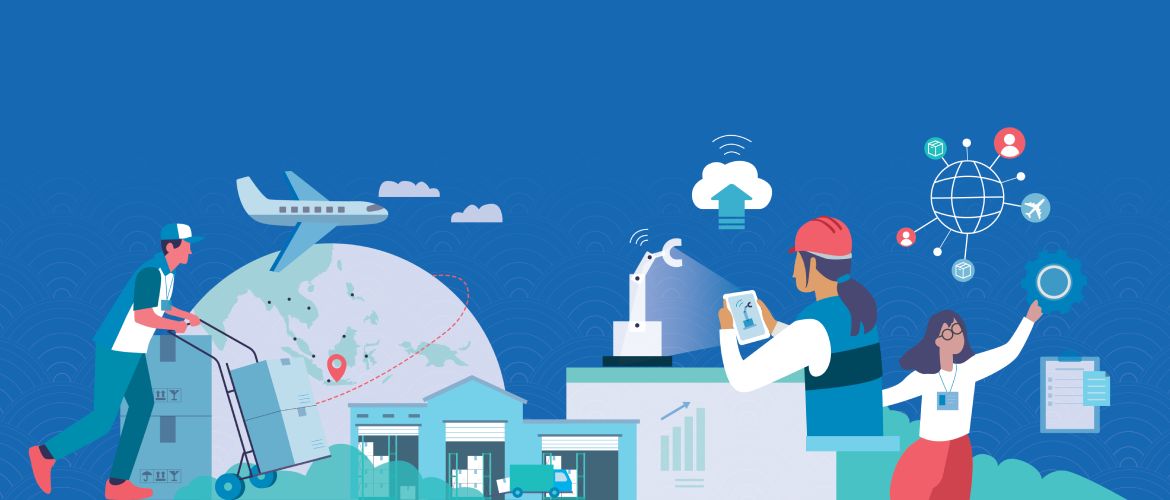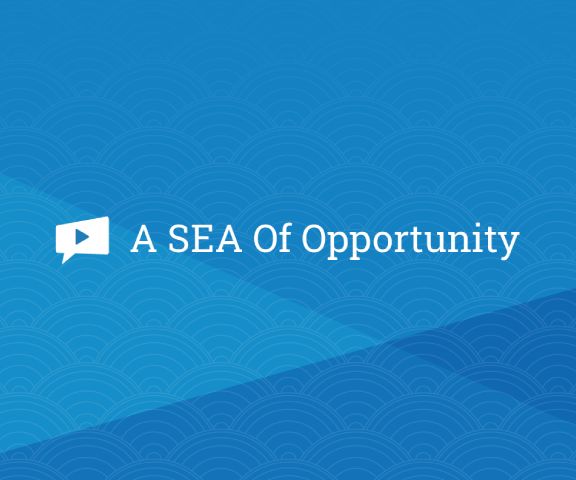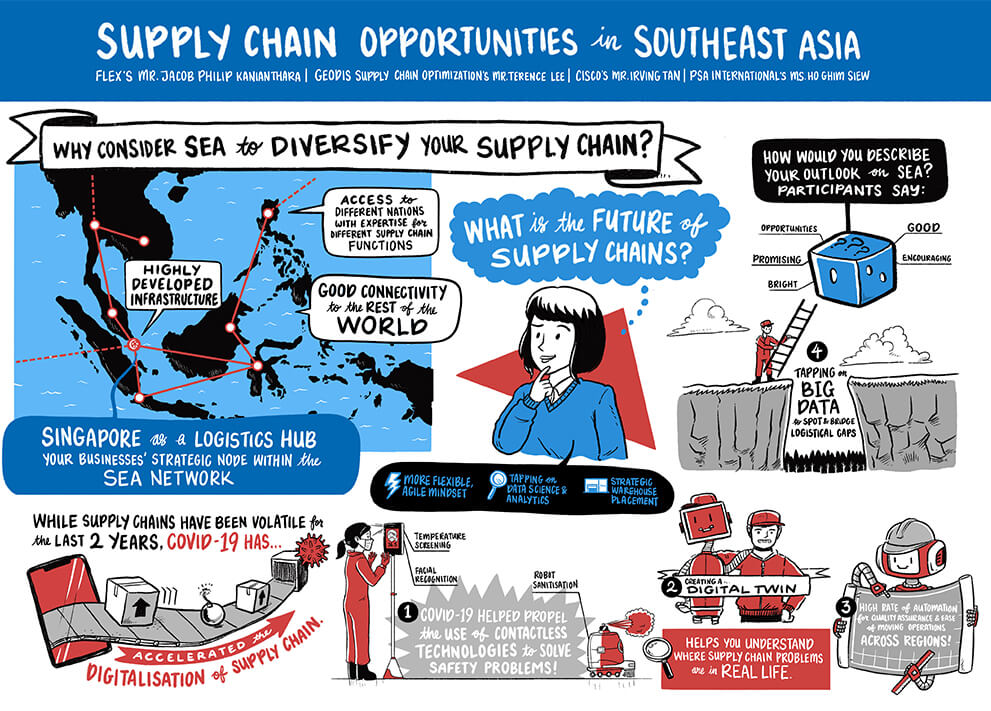Learn how to navigate diverse business opportunities in Southeast Asia
From consumer and supply chain insights, to innovation and startup trends, check out this five-part webinar series to learn more.

How would you describe your supply chains outlook in 2020? “Promising”, “good” and “encouraging” may not immediately spring to mind for the volatile year, but over 400 industry participants in a webinar described opportunities in Southeast Asia (SEA) with optimism.
The webinar, organised by the Singapore Economic Development Board, saw senior leaders from Cisco, Flex, and GEODIS Supply Chain Optimization (SCO) weigh in on supply chain opportunities amid COVID-19, assessing the impact of the pandemic, industry trends, as well as the role of the region.
The panellists included:
Global supply networks have been hit hard, first by United States–China trade tensions and then by the pandemic.
Such disruptions have compelled companies to rethink supply chains, test weak links and look for alternatives. “Everybody took a step back and started to talk about ‘China plus somewhere’. Naturally, SEA started to populate that discussion,” says GEODIS SCO’s Mr Terence Lee.
With its proximity to East Asia and relative political neutrality, SEA allows businesses to retain key market access while spreading assets across locations.

From consumer and supply chain insights, to innovation and startup trends, check out this five-part webinar series to learn more.
Four compelling supply chain opportunities SEA offers:
1. SEA’s diverse capabilities meet diverse needs
A region of 10 interconnected countries, SEA’s different strengths whet a range of appetites.
Panellists noted how countries like Indonesia and Myanmar have strong manufacturing bases, countries like Malaysia, Thailand and Vietnam offer skilled workforces, and hubs like Singapore excel at strategic planning and moving products worldwide.
“We look at SEA as a network, a system. There’s an entire ecosystem of component manufacturers, Printed Circuit Board Assembly manufacturers, contract manufacturers that assemble systems, and logistics providers,” says Cisco’s Mr Irving Tan.
GEODIS SCO’s Mr Lee likens SEA to a biological system, where countries specialise in oversight (“brain”) and others in production (“arms”) or logistics (“feet”) functions — all equally vital members of a robust supply chain.
2. SEA’s location offers connectivity to global markets
Secondary manufacturing locations in Vietnam, Indonesia, Thailand, and Malaysia are becoming popular, helping both China-based and Chinese companies spread risk while remaining close to the massive market, according to Citibank.
Manufacturers also take advantage of Singapore’s connectivity and Free Trade Agreements to push goods to the rest of the world.
In addition, SEA’s own rapidly growing middle class is shifting businesses’ mindsets.
“We have observed in the last months that there’s been a shift from a production- to consumption-driven view of SEA.”
Mr Terence Lee
Chief Procurement Officer
Asia Pacific GEODIS Supply Chain Optimization
“The location of supply chains has moved from ‘where I produce’ to ‘where my products are consumed’,” Mr Lee says.
Bain estimates that 50 million new consumers will join SEA’s middle class by 2022, contributing US$300 billion (S$410 billion) to the region’s hefty disposable income.
Whether businesses are targeting the biggest markets or growing consumer groups, SEA offers access to both.
3. SEA’s digital readiness enables greater agility
COVID-19’s challenges underscore the need for the nimbleness of Industry 4.0.
Flex’s Mr Jacob Philip Kanianthara describes how digital twins map physical operations virtually and calibrate optimal flows of people, equipment and materials in response to disruptions.
“You have access to real-time information across the entire supply chain, and can visualise optimum deployments,” he adds.
In this context, SEA’s shift from labour-intensive to engineering-intensive environments is a huge advantage.
“Some of our most complex flagship innovations are coming out of SEA today, versus China, the US, or Mexico. That’s a function of our people’s technical capabilities and where we see SEA going forward, really moving up the technology stack.”
Mr Irving Tan
Executive Vice President and Chief of Operations
Cisco
As SEA progresses along the technological value curve, its role in a digitalised future will grow.

Build a stronger supply chain in SEA, and look out for these digitalisation trends.
4. SEA’s skilled talent builds sustainable growth
SEA’s workforce is also evolving to embrace high-value capabilities. “Where we used to have expats, today most of our facilities have local leadership,” says Cisco’s Mr Tan.
SEA’s ecosystem features world-class institutes that create a critical pool of supply chain expertise. One prime example is The Logistics Institute (Asia Pacific), a collaboration between the Georgia Institute of Technology and the National University of Singapore, offering talent development programmes in supply chain intelligence, optimisation, and emerging technologies.
SEA’s quality workforce explains Flex’s long-term presence in the region.
“I’m fairly proud to say that in all three countries we have gone into [Singapore, Indonesia, Malaysia], the workforce and the management skillsets have progressed to allow a fair bit of talent localisation.”
Mr Jacob Philip Kanianthara
Vice President of Operations
Flex
While disruptions have been a real test, they also present opportunities for a “reset”.
GEODIS SCO’s Mr Lee describes how clients are relooking operations holistically. Instead of surface adjustments, they probe deeper assumptions about warehousing needs and locations to best serve customers.
SEA certainly offers much value for businesses rethinking supply chains, and in light of global storms, might just be the silver lining they are looking for.
“What you have is really the whole package. Not just costs or people, but a whole ecosystem including talent development, technology and innovation.”
Ms Ho Ghim Siew
Head of Group Commercial, Strategy & Cargo Solutions
PSA International